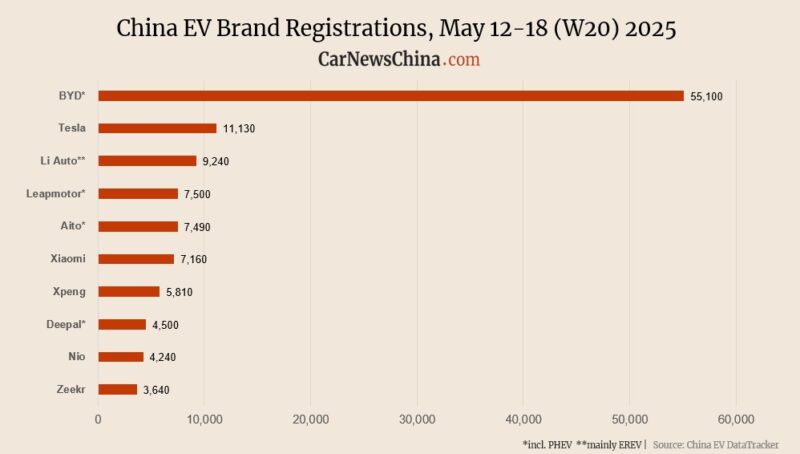The second week of May had mixed signals on the Chinese EV market. Nio was up 8%, Xiaomi was up 38%, Tesla was up 260%, and BYD was down 19% compared with the week before. Onvo sold 1,580 cars and Firefly 830.
In total, 390,000 passenger cars were registered in China last week, up 16.1% year-on-year. Of it, 2180,000 were electric vehicles, up 29.8% year-on-year. The EV penetration reached 55.9%, a new high this year.
Main events to watch:
- Despite lots of negative publicity, Xiaomi is back at the 7k level
- Tesla is back and has had its strongest performance in the last 6 weeks
- Nio’s Onvo is slightly down, Firefly is up 77%
- Nio Group sold 6,650 in total, up 9,7%
- BYD’s Fang Cheng Bao sales are getting close to Denza sales
The weekly sales were published by Li Auto. However, Li Auto ceased publishing them in March 2025 after the China Association of Automobile Manufacturers (CAAM) “recommended” that Li Auto, media and any third parties end it. CAAM says weekly data “undermines the industry order” and “fuels vicious competition.” Since then, Li Auto has published only its own weekly EV registration.
The weekly data are used by consultants, analysts, or investors to see the sales trend and forecast monthly deliveries. They show how many cars were registered for road traffic, which can be later compared with automakers’ self-reported monthly sales, which, unlike registrations, include cars for showrooms, test cars, and other uses.
Most of China’s media have followed CAAM’s recommendation to stop publishing weekly figures. CarNewsChina continues to publish weekly insurance registrations, based on China EV DataTracker data.
The numbers are rounded and present new energy vehicle (NEV) sales, the Chinese term for BEVs, PHEVs, and EREVs (range extenders). To be completely precise, it also includes hydrogen vehicles (FCEVs), but their sales are almost non-existent in China.
Week 20 of 2025 (W20) was between May 12 and 18.
BYD registered 55,100 vehicles, down 18.9% from 67,980 units the week before. In the first two weeks of May, BYD registered 123,080 vehicles in China.
BYD’s premium brand Denza registered 2,920 vehicles, down 2.3% from 2,990 units the week before. In the first two weeks of May, Denza registered 5,910 vehicles in China.
BYD’s off-road brand Fang Cheng Bao registered 2,760 vehicles, up 3.8% from 2,660 units the week before. In the first two weeks of May, Fang Cheng Bao registered 5,420 vehicles in China.

Tesla registered 11,130 vehicles, up 262.5% from 3,070 units the week before. In the first two weeks of May, Tesla registered 14,200 vehicles in China.

Li Auto registered 9,240 vehicles, up 13.2% from 8,160 units the week before. In the first two weeks of May, Li Auto registered 17,400 vehicles in China.
Leapmotor registered 7,500 vehicles, down 3.8% from 7,800 units the week before. In the first two weeks of May, Leapmotor registered 15,300 vehicles in China.
Aito registered 7,490 vehicles, down 0.7% from 7,540 units the week before. In the first two weeks of May, Aito registered 15,030 vehicles in China.
Xiaomi registered 7,160 vehicles, up 38.2% from 5,180 units the week before. In the first two weeks of May, Xiaomi registered 12,340 vehicles in China.
Xiaomi sells a single car – Xiaomi SU7 sedan. It has three basic trims and one performance version, SU7 Ultra with over 1,500 hp. Its second car, the YU7 SUV, will launch around July. Beijing-based smartphone giant raised its 2025 delivery target by 50,000 units to 350,000 vehicles in March. Xiaomi delivered over 135,000 cars in 2024.
Xiaomi sales breakdown to trims:
- 2,755 SU7 Standard
- 2,193 SU7 Pro
- 1,627 SU7 Max
- 582 SU7 Ultra

Xpeng registered 5,810 vehicles, down 15.4% from 6,870 units the week before. In the first two weeks of May, Xpeng registered 12,680 vehicles in China.
Deepal registered 4,500 vehicles, down 4.3% from 4,700 units the week before. In the first two weeks of May, Deepal registered 9,200 vehicles in China.
Nio registered 4,240 vehicles, up 7.9% from 3,930 units the week before. In the first two weeks of May, Nio registered 8,170 vehicles in China.

Onvo registered 1,580 vehicles, down 4.8% from 1,660 units the week before. In the first two weeks of May, Onvo registered 3,240 vehicles in China.
Firefly registered 830 vehicles, up 76.6% from 470 units the week before. In the first two weeks of May, Firefly registered 1,300 vehicles in China.
In total, Nio Group registered 6,650 cars in China, up 9.7% from 6,060 the week before.
In April, Nio Group sold 23,900 vehicles globally, up 58.9% from March and 53% year-on-year. This included 4,400 cars sold by the Onvo brand and 231 by Frefly. Onvo was 9% down in April compared with March.
Nio Group’s sales target is about 440,000 vehicles in 2025 of which Onvo should contribute half. Last year, the company delivered 220,000 vehicles.
Nio’s third brand launched its first EV, Firefly, on April 19. Yes, the brand’s name is Firefly, and the name of the EV is also Firefly. The small electric hatchback starts at 125,800 yuan (16,770 USD) with a battery.
Firefly supports battery swap. However, it can’t swap batteries currently as there are no compatible swap stations. The container swap stations dedicated to Firefly were scrapped, and the fifth-generation swap station, which should support the Nio brand, Onvo, and Firefly, will launch next year with limited availability.
Firefly will launch between June and August in Europe and has already started pre-sales in the Netherlands and Norway.

Zeekr registered 3,640 vehicles, down 15.5% from 4,310 units the week before. In the first two weeks of May, Zeekr registered 7,950 vehicles in China.
Avatr registered 2,400 vehicles, down 8.7% from 2,630 units the week before. In the first two weeks of May, Avatr registered 5,030 vehicles in China.



